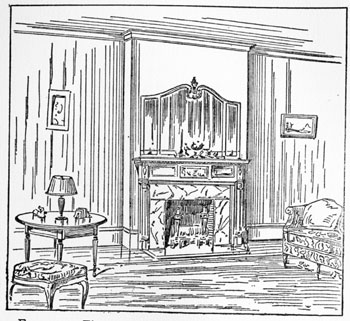The Dominant Element
When the dominant element has been determined the first concern of the decorator, paradoxical as the statement may seem, is to keep it from becoming too conspicuous. It is a law of the mind that, other things being equal, we must attend to the strongest stimulus; and if the dominant element is permitted to catch and hold the eye and constantly to obtrude itself upon the mind, whether by reason of its size, shape, color or position, it will inevitably shut out of consciousness the subordinate elements of the composition, which are no less essential to the beauty of the whole, since they insure the necessary effect of diversity. The dominant element must accordingly be related to the subordinate elements so cunningly that it appears to pervade the room rather than to rule over it. For example, in a small living room the fireplace, if symmetrically placed, would normally be made the dominant feature of the decorative treatment, both because of its architectural importance and because it is the cause and center of social intercourse. A relatively large fireplace, particularly if it were faced with tile or brick either lighter or darker in tone than the walls, or if it projected, with its chimney breast, for some distance into the room, would of necessity be so heavy in a decorative sense that it might very easily be made to seem over-important and destructive of the organic harmony of the room. Therefore any marked increase in its importance, caused, let us say, by the addition of a panelled over-mantel, a large and conspicuous picture or mirror, or of a number of vases, easel pictures, or other objects of striking outline and pronounced coloring, would mar the decorative balance and imperil the beauty of the room. Accordingly he would doubtless find it desirable to confine the embellishment of such a mantel to a few small objects-three, say, or at the most five-or to a plastic frieze toned to analogy if not to identity with the wall. On the other hand, a smaller fireplace in the same room, or the same fireplace in a larger room, might require to have its importance as the dominant element emphasized in the treatment of the over-mantel either by larger and more ornate shapes or more striking coloring, or both.

FIGURE 13.- The very marked projection of the fireplace and the effect of weight produced by its tile facing render the use of striking accessories on the over-mantel unwise.
While the subject will be discussed at length in the chapter on the dominant hue, we may note in this connection that a given hue may be made first in importance by either of two methods. One method is to make all the important hues appearing in the room blood-relations by a process of infusion, technically called keying, in which the dominant hue appears as a constituent of all the other hues. Thus in a scheme of orange, yellow and green the decorator might use light golden brown walls, antique ivory ceiling, olive carpet, olive and gold hangings trimmed with old gold, ecru curtains, soft yellow lamp shades, nut brown fur- niture and woodwork, and olive, brown and gold furniture coverings. Here all the hues would be keyed to yellow, and the unity of the treatment would be ensured by the predominance of that element. Such a color scheme, as we shall see later, would require to be vivified by a note of the complementary color; but this requirement does not affect the general principle involved.

FIGURE 14.- the comparatively slight projection of this fireplace and its general effect of lightness warrant the addition of an important element to the over-mantel.
 "Finally! Step-by-Step Guidebooks Show
"Finally! Step-by-Step Guidebooks Show